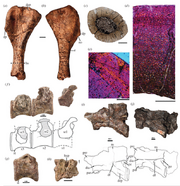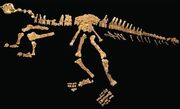(Adding categories) |
No edit summary |
||
| Line 14: | Line 14: | ||
==Description== |
==Description== |
||
''Nyasasaurus'' was an early prosauropod that grew to be about 10 feet long, 3 feet (1 meter) tall a[[File:NyasasaurusThumbnail.jpg|thumb|Nyasasaurus Feeding In Front of Two Placerias]]t the hip, and weigh approximately 135 pounds. Relatively unkown or found is of ''Nyasasaurus'', but we can tell what it may have looked like based on well-known relatives like ''[[Plateosaurus]]''. It had a long, extending neck (a feature that would eventually lead to the mega-sauropods that we all know of) with a small head that allowed it to reach higher into trees to get food than before. It could possibly have been both a biped and an quadruped, with sharp claws on each toe for defense. It also had a long tail that strectched over half its body-length that would[[File:W460.jpg|thumb|left|Nyasasaurus Skeleton]]'ve been helpful in balancing. ''Nyasasaurus'' is currently the oldest-known dinosaur yet found, being 243 million years old, nearly 15 million years older than the previously oldest-known dinosaurs, such as ''[[Herrerasaurus]]'', ''Panphagia'', ''[[Coelophysis]]'', or ''[[Eoraptor]]''. This has shed new light on dinosaur evolution, like how we now know that dinosaurs first evolved from archosaurian reptiles during the Mid-[[Triassic]] and not the Late Triassic like we used to believe, and that dinosaurs evolved from relatively small creatures before evolving into the mega-beasts everyone recognizes. |
''Nyasasaurus'' was an early prosauropod that grew to be about 10 feet long, 3 feet (1 meter) tall a[[File:NyasasaurusThumbnail.jpg|thumb|Nyasasaurus Feeding In Front of Two Placerias]]t the hip, and weigh approximately 135 pounds. Relatively unkown or found is of ''Nyasasaurus'', but we can tell what it may have looked like based on well-known relatives like ''[[Plateosaurus]]''. It had a long, extending neck (a feature that would eventually lead to the mega-sauropods that we all know of) with a small head that allowed it to reach higher into trees to get food than before. It could possibly have been both a biped and an quadruped, with sharp claws on each toe for defense. It also had a long tail that strectched over half its body-length that would[[File:W460.jpg|thumb|left|Nyasasaurus Skeleton]]'ve been helpful in balancing. ''Nyasasaurus'' is currently the oldest-known dinosaur yet found, being 243 million years old, nearly 15 million years older than the previously oldest-known dinosaurs, such as ''[[Herrerasaurus]]'', ''Panphagia'', ''[[Coelophysis]]'', or ''[[Eoraptor]]''. This has shed new light on dinosaur evolution, like how we now know that dinosaurs first evolved from archosaurian reptiles during the Mid-[[Triassic]] and not the Late Triassic like we used to believe, and that dinosaurs evolved from relatively small creatures before evolving into the mega-beasts everyone recognizes. |
||
| − | |||
| − | == History of study == |
||
| − | In the 1930s, fossils of Nyasasaurus were recovered from the Lifua Member of the Manda beds near Lake Nyasa in southern Tanzania by Francis Rex Parrington. Other fossils from the same locality included those of cynodonts, dicynodonts, and rhynchosaurs. Most, including those of Nyasasaurus, consist only of fragments of bone. The remains were first described in English paleontologist Alan J. Charig's 1956 doctoral dissertation and referred to as "Specimen 50b".[2] In 1967 Charig published the name Nyasasaurus parringtoni, in a review of the Archosauria,[3] but without description so that it was commonly considered a nomen nudum; the dissertation also was never published. The generic name referred to Lake Nyasa and the specific name honouring Parrington. In 2012 a new description was published by Sterling Nesbitt, Paul Barrett, Sarah Werning and Christian Sidor, including the late Charig as posthumous co-author, ensuring the validity of the name Nyasasaurus parringtoni.[1] The generic name is occasionally misspelled as "Nyasaurus", as by Theodore Elmer White in 1973.[4] |
||
| − | |||
| − | == Relationships == |
||
| − | Because it is based on incomplete remains, Nyasasaurus has been difficult to classify. It can be placed confidently within Archosauria, the group of reptiles represented today by crocodilians and birds, and within Dinosauriformes, the group that includes birds, non-avian dinosaurs, and several non-dinosaurian groups from the Triassic.[1] |
||
| − | Nyasasaurus was suggested to have been a primitive prosauropod dinosaur in 1986,[5] but this hypothesis was disputed. The 2012 analysis suggests that Nyasasaurus may be the earliest known dinosaur, dating to the late Anisian Stage, about 243 million years ago, 10 to 15 million years older than any previously described dinosaur, such as Herrerasaurus.[1][6] Dinosaur affinities are supported by the long deltopectoral crest on the humerus, with a deflected top; the elongated neck vertebrae with hollowed-out sides; and, perhaps, the possession of three sacral vertebrae instead of two.[citation needed] |
||
| − | Nyasasaurus is likely either a basal dinosaur or close to Dinosauria. Other phylogenetic analyses have indicated that the sister taxon or most closely related group to Dinosauria is a family of herbivorous dinosauriforms called Silesauridae. The fossil record of silesaurids dates back to the late Anisian (the silesaurid Asilisaurus kongwe is also known from the Manda Beds), suggesting that the first dinosaurs also appeared around this time. Before Nyasasaurus was recognized as a possible dinosaur, a long ghost lineage existed between the earliest dinosaurs and silesaurids. |
||
| − | The 2012 study of Nyasasaurus incorporated both specimens, NHMUK R6856 and SAM-PK-K10654, into a phylogenetic analysis. This analysis was based on data from a 2011 analysis by Sterling Nesbitt that included many Triassic archosaurs.[1] When NHMUK R6856 was added to the data set, several possible relationships were found. Various possible evolutionary trees place it as the sister taxon of Dinosauria, the most basal member of Ornithischia (the group that includes most herbivorous Mesozoic dinosaurs), or a member of Theropoda (the group that includes most carnivorous dinosaurs as well as birds). When SAM-PK-K10654 was added to the analysis, it was found to be a theropod. SAM-PK-K10654 possesses several theropod features, including deep pits or fossae in its neck vertebrae, which are not found in NHMUK R6856. The following cladogram depicts these possibilities: |
||
| − | |||
| − | |||
| − | {{clade| style=font-size:100%;line-height:85% |
||
| − | |label1=[[Archosauria]] |
||
| − | |1={{clade |
||
| − | |1 = [[Pseudosuchia]] (including [[crocodilian]]s) |
||
| − | |2={{clade |
||
| − | |1=[[Pterosauromorpha]] |
||
| − | |2={{clade |
||
| − | |1=[[Lagerpetidae]] |
||
| − | |label2=[[Dinosauriformes]] |
||
| − | |2={{clade |
||
| − | |1=''[[Marasuchus lilloensis]]'' |
||
| − | |2={{clade |
||
| − | |1=[[Silesauridae]] |
||
| − | |2={{clade |
||
| − | |1='''NHMUK R6856'''|state1=dashed |
||
| − | |label2='''[[Dinosauria]]''' |
||
| − | |2={{clade |
||
| − | |label1=[[Ornithischia]] |
||
| − | |1={{clade |
||
| − | |1='''NHMUK R6856'''|state1=dashed |
||
| − | |2=Other ornithischians}} |
||
| − | |label2=[[Saurischia]] |
||
| − | |2={{clade |
||
| − | |1=[[Sauropoda]] |
||
| − | |label2=[[Theropoda]] |
||
| − | |2={{clade |
||
| − | |1=''[[Herrerasaurus ischigualastensis]]'' |
||
| − | |2={{clade |
||
| − | |1=''[[Staurikosaurus pricei]]'' |
||
| − | |2={{clade |
||
| − | |1=''[[Eoraptor lunensis]]'' |
||
| − | |2={{clade |
||
| − | |1='''SAM-PK-K10654''' |
||
| − | |2={{clade |
||
| − | |1=''[[Tawa hallae]]'' |
||
| − | |2={{clade |
||
| − | |1=''[[Coelophysis bauri]]'' |
||
| − | |2={{clade |
||
| − | |1={{clade |
||
| − | |1='''NHMUK R6856'''|state1=dashed |
||
| − | |2=''[[Dilophosaurus wetherilli]]''}} |
||
| − | |2=Other theropods (including [[bird]]s) |
||
| − | }} }} }} }} }} }} }} }} }} }} }} }} }} }} }} }} |
||
==References== |
==References== |
||
Revision as of 21:30, 13 February 2013
| Nyasasaurus | ||||
|---|---|---|---|---|
 | ||||
| Name | Nyasasaurus | |||
| Order | Saurischia | |||
| Suborder | Prosauropoda | |||
| Name Translation | Nyasa Lizard | |||
| Period | Mid Triassic 243 Million Years Ago | |||
| Location | Africa | |||
| Diet | Herbivore | |||
| Size | 3 m (10 ft) long | |||
Nyasasaurus (nye-AS-suh-SORE-us) was the earliest-known dinosaur, living about 243 million years ago during the Mid-Triassic in what is now Tanzania. It grew to be about 10 feet (3 meters) long, and was a very early prosauropod.
Discovery
Nyasasaurus was originally discovered in 1956, but wasn't officialy named or described as its own species until Dece

Nyasasaurus Bone Fragments
mber 2012. It was kept in an English museum collecting dust for over 50 years until some scientists started looking through the museum dinosaur-bone storage area and rediscovered this important find. It was unearthed in Tanzania, Africa by Francis Rex Parrington sometime around 1930, and for many years was kept hidden and nearly unkown. It was first described by a paleontologist named Alan J. Charig in 1956, but it was never truly published and wasn't fully described until 2012. It was first found in fossil beds near Lake Nyasa in soil layers that suggested it came from the Mid-Triassic about 243 million years ago.
Description
Nyasasaurus was an early prosauropod that grew to be about 10 feet long, 3 feet (1 meter) tall a

Nyasasaurus Feeding In Front of Two Placerias
t the hip, and weigh approximately 135 pounds. Relatively unkown or found is of Nyasasaurus, but we can tell what it may have looked like based on well-known relatives like Plateosaurus. It had a long, extending neck (a feature that would eventually lead to the mega-sauropods that we all know of) with a small head that allowed it to reach higher into trees to get food than before. It could possibly have been both a biped and an quadruped, with sharp claws on each toe for defense. It also had a long tail that strectched over half its body-length that would

Nyasasaurus Skeleton
've been helpful in balancing. Nyasasaurus is currently the oldest-known dinosaur yet found, being 243 million years old, nearly 15 million years older than the previously oldest-known dinosaurs, such as Herrerasaurus, Panphagia, Coelophysis, or Eoraptor. This has shed new light on dinosaur evolution, like how we now know that dinosaurs first evolved from archosaurian reptiles during the Mid-Triassic and not the Late Triassic like we used to believe, and that dinosaurs evolved from relatively small creatures before evolving into the mega-beasts everyone recognizes.
References
http://en.wikipedia.org/wiki/Nyasasaurus_parringtoni
http://news.discovery.com/animals/oldest-dinosaur-found-121204.html#mkcpgn=rssnws1
http://www.science20.com/news_articles/nyasasaurus_parringtoni_oldest_dinosaur_found_so_far-98092